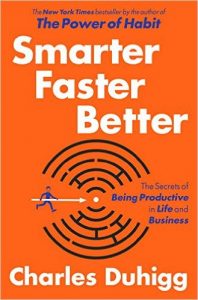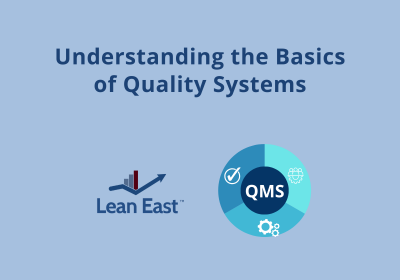This is part of an ongoing series of organizational and personal improvement book reviews. If you have read the book already, use this as a reminder of key lessons. If you have not read the book and are looking to learn and grow as a leader, this summary will share the basics.

Smarter Faster Better: The Secrets of Being Productive in Life and Business is a 2016 book (and already a bestseller) written by Charles Duhigg. He is also the author of the 2012 bestselling book The Power of Habit: Why We Do What We Do in Life and Business.
Duhigg is a storyteller with a style similar to Malcolm Gladwell and Atul Gawande. The book is broken into eight topics, each with its own chapter. Those looking for a quick synopsis can always read Duhigg’s “Reader’s Guide to Using These Ideas” in the Appendix.
Many topics in the book were familiar to me already, as were some of the stories. Overall, I found the book to be a little too long. It seemed as though I could have learned about the same much more quickly from reading a summary like this one. Like any book, the stories and examples give each lesson context and make them more memorable. So, read the book or chapter if you want to learn more than just what you read in this summary.
Here are the eight topics with my synopsis of the key lessons from each chapter:
1. MOTIVATION:
When dealing with an annoying task, make the chore into a meaningful decision. That way, you feel as though you have a greater sense of control. Then remind yourself of the reason for completing the chore in the first place . . . your long-term values and goals this chore will support.
One way to prove to ourselves that we are in control is by taking a bias towards action and making a decision. Duhigg experienced personal success when cleaning up his inbox by writing the first line of his email response. Later he found it much easier to finish the remainder of the response (the filler) and click “send.”
2. TEAMS:
When leading a team be sure to encourage equity in the participation of team members. Model listening, and demonstrate sensitivity to what your teammates think and feel. “Social sensitivity” is the skill in demand here. When team members feel psychological safety on the team they will perform better in the long run. Excellent internal research from a project at Google is shared about what makes a successful team.
3. FOCUS:
To become genuinely productive, we must take control of our attention; we must build mental models that put us firmly in charge. For example, envision beforehand how you will lead an important meeting. Or mentally practice how you will answer questions confidently at your interview. The key is in forcing yourself to think in advance so that when a situation arises you have already practiced how you want to act. Sometimes it seems like gut instinct, but it is really about knowing what “success” looks and feels like . . . so that you will know it when you see it.
Oh, and working on too many things at once is counter-productive. Choose only a handful of initiatives at a time. It is too easy to lose focus by jumping from one target to another.
4. GOAL SETTING:
You must have a detailed, actionable plan for attaining goals but also take the time to dream big and create BHAGs. The solution is to write a to-do list that pairs stretch goals and SMART goals. First, dream big and come up with a menu of your biggest ambitions. Then choose one aim and start breaking it into short-term, concrete steps. Complete these small steps until you have achieved your big goal.
“Write a to-do list that pairs stretch goals and SMART goals”
5. MANAGING OTHERS:
Lean and agile thinking to establish a culture of trust is the most successful model for managing teams and organizations, and is well understood by Lean East. The Toyota production system, also known as Lean manufacturing, relies on pushing decision-making to the lowest possible level in an organization. It’s not improvement tools that make Toyota successful, it’s the culture of trust. Duhigg shares the story of the General Motors partnership with Toyota for their Fremont, California plant. Many of the same unionized auto workers who were believed to have contributed to this plant having some of the worst quality metrics in the industry had excellent results (in quality, delivery, safety, and cost) using Toyota’s Lean thinking.
Lean management systems are well known for cultures where all employees feel respected and listened to. Firms following the “commitment” model believe that getting the culture right is more important at first than designing the best product or service. A large study found that the only corporate culture that was a consistent winner were firms with a culture of commitment.
6. DECISION MAKING:
Making good choices relies on forecasting the future, and accurate forecasting requires exposing ourselves to as many successes and disappointments as possible. You must learn from both the accomplished and the humbled . . . both the upside and downside possible outcomes. It is important to understand the “prior” or “base rate” when predicting the likelihood of any outcome and not falling into the trap of common biases.
The next time you have a bad day or you snap at your partner, don’t simply tell yourself that things will go better next time. Instead, force yourself to really figure out what happened. Then use those insights to forecast more potential futures, to dream up better possibilities of what might occur. This will give you better odds of making a great decision.
“Creativity is just problem solving”
7. INNOVATION:
Creativity can’t be reduced to a formula. At its core, it needs novelty, surprise, and other elements that cannot be planned in advance to seem fresh and new. But the creative process is different.
To improve the process, first, be sensitive to your own experiences; pay attention to how things make you think and feel. Second, embrace the panic and stress you feel as you try to create. Finally, regain critical distance from your initial solution by forcing yourself to critique what you’ve just done, but from a completely different perspective. The key is realizing that creativity is just problem-solving.
8. ABSORBING DATA:
People who are most successful at learning take data and transform it into experiments whenever they can. Researchers found that taking notes by hand while watching a lecture is better than using a laptop. Writing in shorthand forces the note taker to think more about what they are writing, leading to better recall later. When we encounter new information and want to learn from it, we should force ourselves to do something with the data. I believe teaching others may be the best way to learn for yourself!
We hope this summary of Smarter Faster Better: The Secrets of Being Productive in Life and Business is helpful to you and your team. Please send us your feedback and questions or share any additional lessons you took away from the book and check out other posts.




